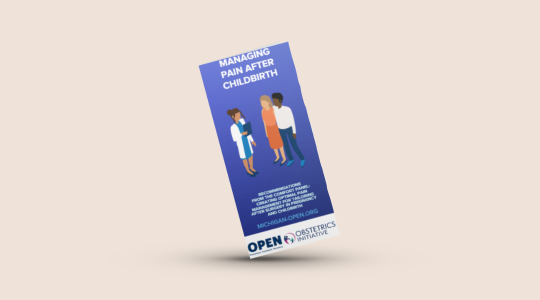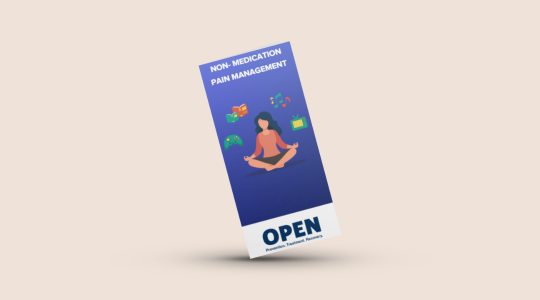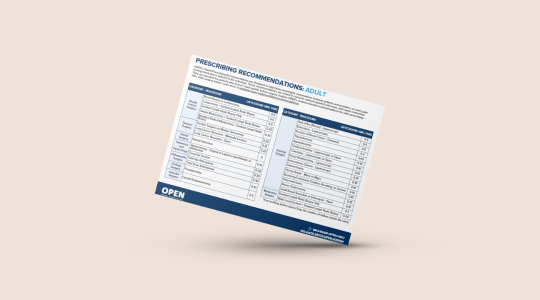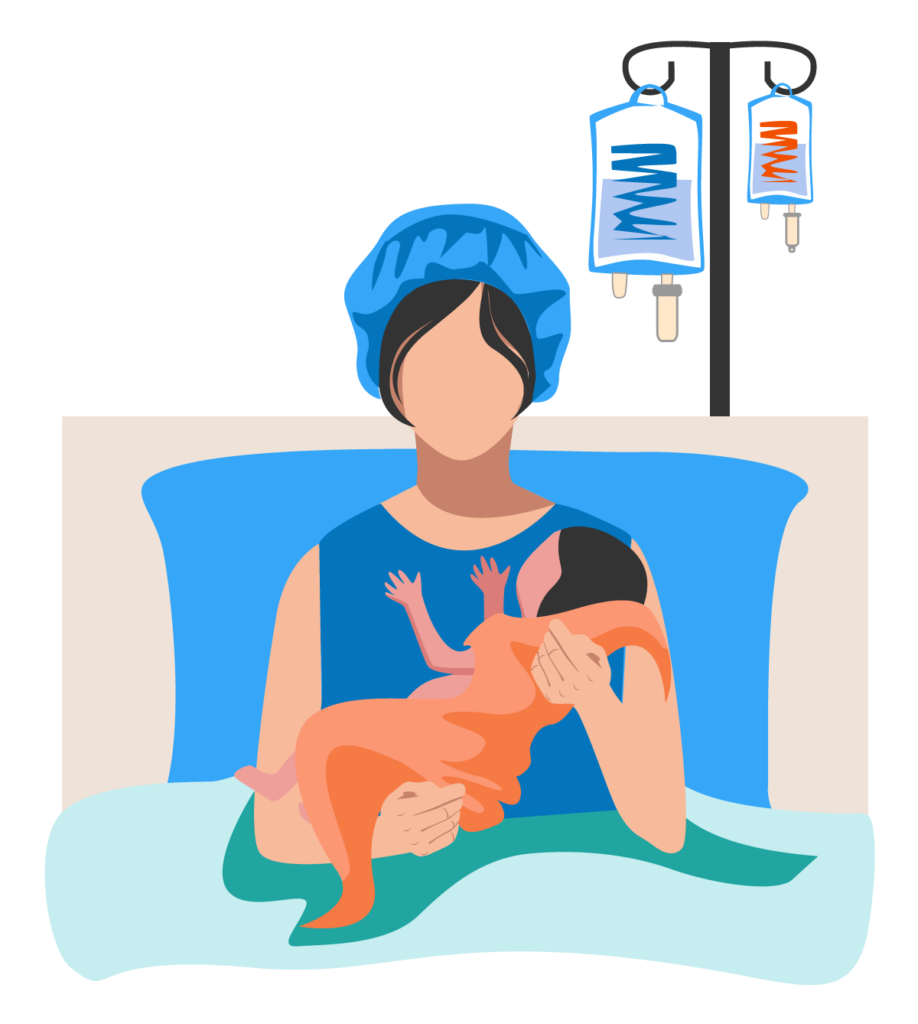Preparing to give birth can be stressful, which is why OPEN strives to educate patients and healthcare providers for best practices to manage pain before and after birth. For patients, it is important to establish a plan for your pain management and know which medications are safe to use while breastfeeding. For healthcare providers, it is important to understand the current problem with opioid prescribing for after-birth care, as well as possible solutions moving forward. Focusing in on centering the patient and assessing individual factors can be key in setting up your patient for success. Understand which educational materials may be beneficial to them, which medications to prescribe, and which non-pharmacological strategies to recommend. Keep in mind different inpatient strategies and that patients with complex pain management needs may need different care.

 There are many ways to manage pain after having a baby. Your clinician will discuss with you the different recommended options based on the kind of birth and pain you are experiencing and answer any questions you have. Together, you and your clinician can choose what options are best for you. Your clinician will talk to you about your beliefs, wishes, and values related to pain management and how the following may influence your pain plan:
There are many ways to manage pain after having a baby. Your clinician will discuss with you the different recommended options based on the kind of birth and pain you are experiencing and answer any questions you have. Together, you and your clinician can choose what options are best for you. Your clinician will talk to you about your beliefs, wishes, and values related to pain management and how the following may influence your pain plan:
The goal of pain management is for you to do daily activities like eating, sleeping, breathing deeply, and walking for yourself and to take care of your infant.
Some types of pain are NOT normal. If you see these signs, call your clinician: pain that is severe, rating 10/10 , pain that prevents you from sleeping, pain that does not get better with medication, fever, foul-smelling vaginal discharge, redness or drainage at your incision, heavy vaginal bleeding (soaking through >1 pad/hour), or headaches.

Learn ways to manage pain after childbirth such as: over-the-counter medications, non-medication strategies, and opioids, if prescribed.
Documenting your pain management preferences and sharing them with your clinician can help you work together to develop a plan that’s right for you. Below are several options for pain management after childbirth that can be incorporated into your plan.
Use non-opioid medications, like acetaminophen and ibuprofen, for as long as you are having pain. These medications can help lessen your pain and are usually well-tolerated with few side effects. You can take these medications together at the same time OR staggered at different times. Choose one!

TOGETHER
Patients may choose to take medications together at the same time because of busy schedules.
7AM – Acetaminophen (1000mg) + Ibuprofen (800mg)
3PM – Acetaminophen (1000mg) + Ibuprofen (800mg)
11PM – Acetaminophen (1000mg) + Ibuprofen (800mg)
STAGGERED
Patients may choose a staggered schedule if pain is more severe.
7AM – Acetaminophen (1000mg)
11AM – Ibuprofen (800mg)
3PM – Acetaminophen (1000mg)
11PM – Ibuprofen (800mg)
There are many techniques to reduce pain that do not require medications. Choose options you would like to try:
Sometimes an opioid medication may be needed for a short time to manage pain. Most patients who have a vaginal birth do NOT need an opioid medication. Even 60% of patients after cesarean birth reported not needing an opioid when using other options to manage pain. If an opioid medication is needed, your clinician will work with you to find the right opioid prescription size. Opioids are prescription pain medications that may be offered by your prescriber after birth.

Small amounts of opioids over short periods of time are safe and do not pose risks to babies, but some opioids (codeine, tramadol) are not recommended when breastfeeding.
Acetaminophen and ibuprofen are both safe during breastfeeding. They are found in low amounts in breast milk and are the first choice for pain management.
Talk to your prescriber if you are breastfeeding about the best option for you. Call your pediatrician if your baby seems sleepier than normal, cannot suck as well or is constipated.
Anyone who uses an opioid, even for just a short time, is at risk for dependence, tolerance, misuse, addiction, and overdose. Opioids can cause slowed breathing and lead to overdose death. Opioids are also associated with several side effects. Contact your clinician if you notice any side effects.
Discuss the following signs and symptoms of an overdose with your family and friends:
The COMFORT clinical practice guideline (CPG) is designed to promote care standardization (i.e., all patients receive the same pain management choices supported by evidence) and personalization (i.e., patients and clinicians select from evidence-based options to create tailored care plans responsive to individual patient needs, preferences, and values). This CPG was developed using a rigorous process including systematic review, consensus methodology, and patient and clinician voices. Visit the Managing Pain After Childbirth Toolkit to learn more.
Offering everyone the same choices supported by evidence, and deciding on the best options through partnership between clinicians and patients, may help promote better clinical outcomes, better experiences of care, reduced risk of opioid harms, and more equitable outcomes for all.


A practical guide for clinicians to learn more about implementing the COMFORT (Creating Optimal Pain Management for Tailoring Interventions after Childbirth) Clinical Practice Guideline.
![]() BEST PRACTICE:
BEST PRACTICE:
No two patients or birth experiences are identical. Therefore, pain management plans should be tailored to an individual’s needs.
When providing patient-centered care, it is crucial to thoroughly assess each individual’s unique preferences, mental health status, history of trauma, type of birth, as well as their current and past medications and substance use, to ensure the most appropriate and compassionate care is delivered.
![]() BEST PRACTICE:
BEST PRACTICE:
A patient, and if desired, their support person, should receive counseling (ideally prior to the birth admission) that reviews expectations of pain experience and pain management options following all modes of delivery and complications.
Establishing clear expectations for pain management and the range of sensations that may be experienced during the birthing process is essential for empowering patients and facilitating a more informed and less anxiety-provoking childbirth experience.
How pain management differs across mode of delivery and procedures:
Even patients planning vaginal birth should receive information about the possibility of cesarean birth and pain management.
Expectations for recovery after childbirth:
Help patients know what to expect after birth, including normal and abnormal pain.
First-line pain management should include non-opioid and non-pharmacologic strategies:
Acetaminophen and NSAIDs should be used together as first-line medications for postpartum pain unless contraindicated*.
Offer a menu of non-pharmacological strategies that may improve the pain experience.
Patients requiring an opioid prescription should receive information on how to safely use the medication and harm reduction strategies. Sample topics to cover:

![]() BEST PRACTICE:
BEST PRACTICE:
Prescribe acetaminophen and an NSAID at discharge. All patients, without contraindication, should be prescribed scheduled acetaminophen and an NSAID after childbirth to reduce baseline pain.
Since acetaminophen and most NSAIDs are available over the counter and don’t require a prescription, patients and support persons often do not receive instructions on how to use them after surgery. Following packaging instructions may result in underdosing. Additionally, some patients may not be able to pay out of pocket for medications. Universally prescribing acetaminophen and NSAIDs can ensure: patients know the right dosing; non-opioid medications are used first-line; and all patients have access to these medications.
Ibuprofen is the NSAID most studied in pregnancy. Other NSAIDs may be appropriate if preferred by the patient or provider for dosing intervals or other considerations.
Why? There is a moderate to high level of evidence to support scheduled Acetaminophen (Tylenol®) and ibuprofen (Motrin®) after both vaginal and cesarean birth for effective pain management and reduced opioid requirements.2
What about lactation? Acetaminophen and ibuprofen are both safe during breastfeeding. They are found in low concentrations in breast milk and are the first choice for pain management for lactating parents.
What about Cesarean Birth? For the first 24 hours postpartum, the first 3 doses of oral NSAID, can be replaced with 3 doses of Toradol 15 mg IV every 8 hours.

Schedules are based on every 8 hour dosing. Dosing medications every 6 hours may also be appropriate (e.g., acetaminophen 650mg q6 and ibuprofen 600mg q6 together or staggered).
TOGETHER
7AM – Acetaminophen (1000mg) + Ibuprofen (800mg)
3PM – Acetaminophen (1000mg) + Ibuprofen (800mg)
11PM – Acetaminophen (1000mg) + Ibuprofen (800mg)
STAGGERED
7AM – Acetaminophen (1000mg)
11AM – Ibuprofen (800mg)
3PM – Acetaminophen (1000mg)
11PM – Ibuprofen (800mg)
TOGETHER: taking Acetaminophen and Ibuprofen at the same time.
STAGGERED: alternating taking Acetaminophen and Ibuprofen.

![]() BEST PRACTICE:
BEST PRACTICE:
Offer patients a menu of non-pharmacologic options that may help manage pain.
While evidence for many non-pharmacologic strategies is limited, these interventions are low-risk with potential for benefit. In combination with other opioid-sparing strategies, non-pharmacologic interventions can potentially improve a patient’s pain experience. Clinicians should present non-pharmacological strategies as supplemental to routine postpartum pain management to avoid minimizing patients’ pain. Use caution and appropriate timing when offering non-pharmacological strategies. Consider emphasizing that these strategies may accompany first-line treatments used to manage pain but should not replace them.

Learn how to help manage or reduce your pain and anxiety through various techniques.
Abdominal Binder | Heat / Ice | Acupuncture / Acupressure |
Mindfulness | Music | Aromatherapy |

![]() BEST PRACTICE:
BEST PRACTICE:
Opioid stewardship practices can promote excellent pain management while minimizing the risks of opioid prescribing.
When an opioid is needed, use the COMFORT Panel prescribing ranges as the foundation for a shared decision-making conversation with the patient to determine the best prescription size. Starting from a standardized approach and then allowing for individualization helps to promote both equity and patient-centeredness.
Determine the opioid prescribing range based on:
Determine the right prescription size:

*Clinicians should be aware of inequities in how pain is assessed and treated.

Use OPEN’s evidence-based prescribing recommendations for tailored pain management after surgery in adult patients.
| Prescription range (in 5mg tabs of oxycodone) | |
|---|---|
| Routine Vaginal Birth + VBAC | 0 |
| 3rd or 4th degree laceration | 0-5 |
| Postpartum sterilization with minilap | 0-5 |
| Cesarean birth, discharged POD2 | 0-15 |
| Wound vacuum | 0-15 |
| Peripartum hysterectomy | 0-10 |
| Dilation and Curettage | 0 |
| Uterine Artery Embolization | 0 |
| Postpartum endometritis, antibiotics complete | 0 |
Note: For patients at risk of inadequate pain management (e.g., cannot receive NSAIDs/Acetaminophen): Consider prescribing closer to the upper range. For patients at risk of adverse effects of opioid medications (e.g., use of sedating medications, non-opioid SUD): Consider prescribing closer to the lower range.
| DO | AVOID | |
|---|---|---|
| Opioid Selection | Prescribe oxycodone, morphine, or hydromorphone, for all patients regardless of lactation plans. Limit prescription size to 30mg/day of oxycodone or the equivalent (45 OME) in lactating patients. | IV opioids where possible Prescribing opioids that contain acetaminophen (e.g. Norco®, Vicodin®, Percocet®) to minimize risk of acetaminophen overdose Prescribing codeine or tramadol for all patients regardless of lactation plans due to risk of ultrarapid metabolism and infant sedation. |
| Discharge Prescribing | If an opioid is indicated at discharge, follow the clinician tool for discharge opioid prescribing | Preemptive opioid prescribing when there is uncertainty about a patient’s postpartum pain needs |
| Co-Prescribing | Consider co-prescribing naloxone for ALL patients, particularly for patients at high risk, such as those with: -History of substance use/tobacco use -Chronic pain -Sleep apnea -Mental health conditions -Taking opioids for more than a few days | Prescribing opioids with other sedative medications (e.g., benzodiazepines, skeletal muscle relaxants) |

![]() BEST PRACTICE:
BEST PRACTICE:
All patients should receive long-acting regional anesthesia after cesarean birth.
Implementing tailored pain management strategies that align with the specific requirements of a vaginal or cesarean birth is vital to ensure each patient receives the most effective and appropriate care for their unique childbirth experience.
Patient Controlled Analgesia with IV medications may be appropriate for patients who do not have adequate pain control with routine measures after cesarean birth or cannot receive routine pain control.
Transversus Abdominis Plane (TAP) Block, Ketamine infusion, surgical site infiltration with local anesthetic and perioperative gabapentin has uncertain benefit for patients who do not have adequate pain control with routine measures or cannot receive routine pain control after cesarean birth.
Considerations for practice:
NO BENEFIT
Patients who receive long-acting regional analgesia following routine cesarean birth DO NOT BENEFIT from additional inpatient pain management strategies like TAP block, surgical site infiltration with local anesthetic, or IV PCA.
MAY BENEFIT
Patients who cannot receive long-acting regional analgesia following cesarean birth, have complex pain management needs (e.g., patients with OUD, chronic pain), or have poorly controlled pain after birth MAY BENEFIT from additional inpatient pain management strategies.
Surgical site infiltration with local anesthetic has uncertain benefits for patients who do not have adequate pain control with routine measures after vaginal birth.
Transversus Abdominis Plane (TAP) Block and Ketamine infusion are inappropriate, and long-acting regional analgesia, Patient Controlled Analgesia with IV medications, and perioperative gabapentin are likely inappropriate for patients who do not have adequate pain control with routine measures after vaginal birth.

![]() BEST PRACTICE:
BEST PRACTICE:
Clinicians should use a principles based approach to managing pain in patients with complex pain. Where possible, clinicians should offer patients COMFORT with some additions and specific considerations.
Clinicians should have a set of principles to guide them when treating people with complex pain cases. They should aim to keep the patient as comfortable as possible, with a few extra steps and special things to keep in mind for each person’s situation.


Learn ways to manage pain after childbirth such as: over-the-counter medications, non-medication strategies, and opioids, if prescribed.

A practical guide for clinicians to learn more about implementing the COMFORT (Creating Optimal Pain Management for Tailoring Interventions after Childbirth) Clinical Practice Guideline.

Learn how to help manage or reduce your pain and anxiety through various techniques.